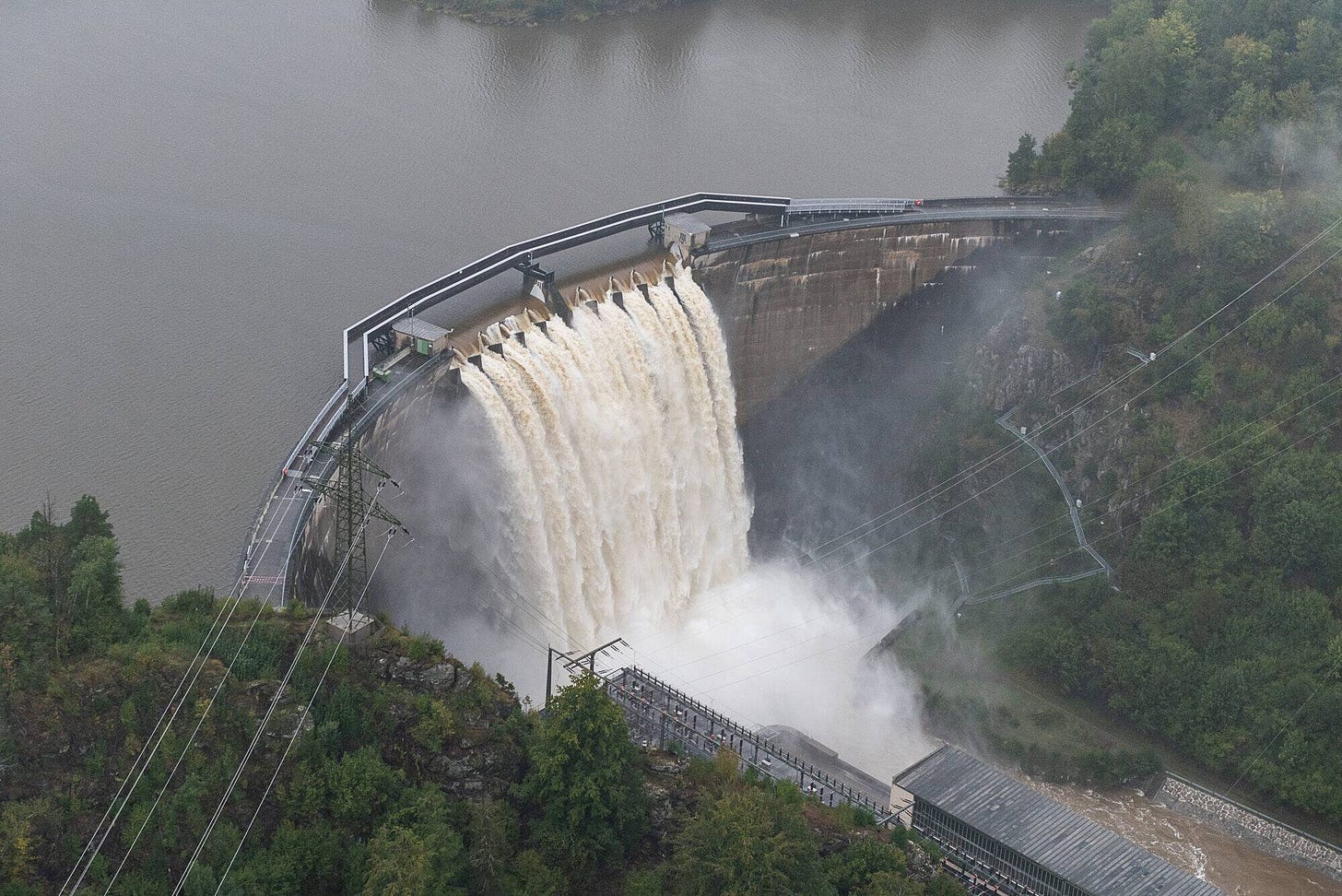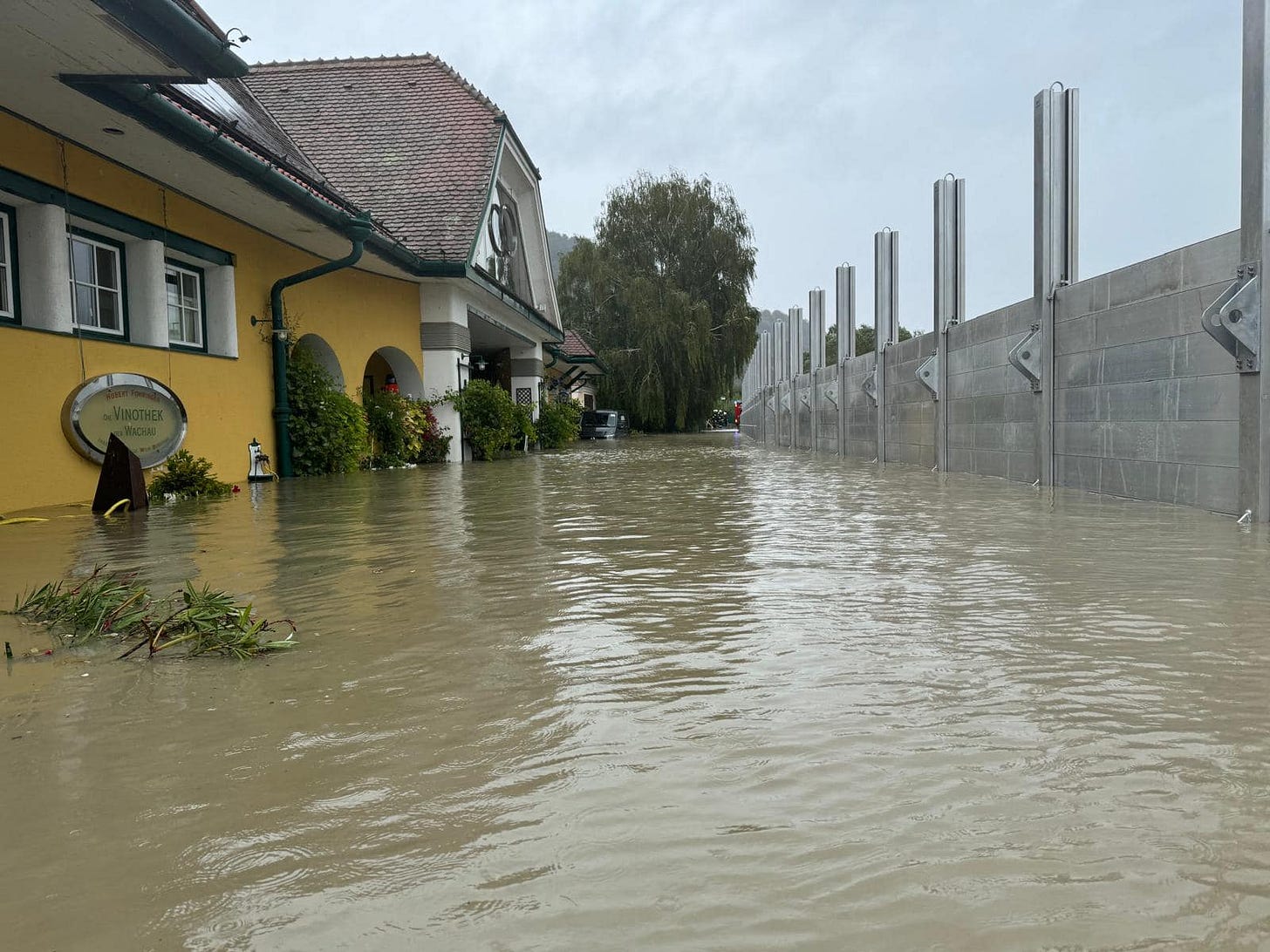Lower Austria's Winemakers Hit by Floods
Harvests along the Danube compromised by the worst flooding for decades
The original plan for this week was to publish my ‘best of’ from the Single Vineyard Summit in Kamptal, Lower Austria. In light of the very severe flooding across the whole region, it does not feel appropriate to write about the best wines or top producers. Instead, here is a brief update on the situation for growers on the ground. This is a free post for all to read.
Just a week ago, I strolled around the beautiful gardens of Grafenegg Castle on a warm September day. Winemakers in the surrounding regions of Kamptal, Kremstal, Traisental and Wagram were mid-way through harvest. Most still managed to show their faces at the Single Vineyard Summit, the massive trade tasting of top wines from the 77 members of the Traditions Weingüte (ÖTW).
Wagram-based Winemaker Martin Diwald was the first to flag up what was coming, when we met for a catch-up one evening. He joked about conditions going from heatwave to flood, and sent me this forecast a few days before the heavens opened.
As is often the case with extreme weather events, the initial forecast massively underestimated the extent of Storm Boris. In just five days, 423 litres per cubic meter fell over the area of Sankt Pölten - more than half the average annual rainfall.
By Sunday 15 September, the whole of Lower Austria had been declared a disaster zone, with countless towns, villages and communities without power and some inhabitants waiting to be airlifted to safety. The flooding has also been very serious throughout central and eastern Europe, including southern Czechia, Bratislava, Hungary, Poland and Romania. The Danube and the many rivers that feed into it are the hotspots. The Kamp and Krems suffered particularly severe swelling, and the Vienna river burst its banks.
Some of the scariest images were of the massive Ottensee reservoir in the Waldviertel to the north of Wachau and Kamptal. The reservoir overflowed and has been discharging around 120 litres per cubic metre per second down the river Kamp, causing flooding further downstream in the Kamptal region.
As of today, Wednesday 18 September, it’s stopped raining in Lower Austria and the sun has returned. Now winemakers need to take stock of the situation. Further east in Burgenland, many had finished harvesting before the rain started - 2024 has been one of the earliest harvests on record across Europe. But in Wagram, Kamptal and Kremstal, most were mid-way through picking.
Martin Diwald told me that although they were not directly affected by flooding, strong winds and rain caused damage to the vines that was like “hail damage but without the hail.” Further west in Langenlois (Kamptal), Alwin Jurtschitsch reported that “we and the winery are all fine. Some vineyards around Zöbing got wet feet. It is not as bad as 2002 - till now.” He remarked on how strange it was to see Black Hawk helicopters flying around the area carrying giant sandbags.
Still further west into Wachau, harvest was not so far advanced. Domäne Wachau’s director Roman Horvath told me that only about 10-20% of the grapes were already picked when the storms began. The Wachau has flood defences along the Danube that were built over the last two decades as a response to the 2002 floods1. These seem to have worked in most cases. Broken sewers in Spitz an der Donau caused wine merchant Vinothek Fohringer to be completely flooded out.
The issue now is the effect on the grapes left on the vine. Massive amounts of rain mean it will take a while for the grapes to dry out, and rot is now a serious issue. As Horvath explains “it will be a long tedious picking, [with a] lot of selection in the vineyard and dumping infected grapes.”
Flooding was also very severe in the Weinviertel, Austria’s largest wine region stretching North of Vienna and up to the Czech border. In Zellendorf, Katharina Gessl told me of “crazy flooding in the region, but luckily our vineyards were not affected yet”.
Events like this are part of the reason why you won’t find many climate change deniers amongst the wine-making community. The narrative has changed. Just a few decades ago we talked of global warming, now the picture is far more complicated. ‘Expect the unexpected’ is the only pattern. Hardly reassuring when your livelihood is based around a single harvest representing an entire year’s work.
This was corrected on September 19th, from the original text where I incorrectly implied that the flood defences were built in 2022. In fact they were mostly finished by 2013, but only 100% complete by 2022. Thanks to Roman Horvath for providing this clarification.






Following this horror scenario brings back memories of extremely localized but unprecedented precipitation that three summers ago, almost from one hour to the next, engulfed my own property in a destructive, heretofore unimaginable 1.5 meter torrent.
Sep Mantler has been reported as suggesting that conditions this year were unfortunately conducive to relatively brittle, fragile grape skins, which would aggravate the risk of rupture when the vines pump water. And while its obvious that lower-lying or more level vineyard sites and those with heavier soils will be slower in drying to the point where treaded vehicles can enter, I'm getting reports of Weingartswege being washed out in steep, stony locations like the Kamptal's iconic Heiligenstein.